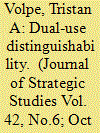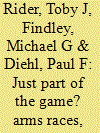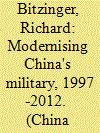|
|
|
Sort Order |
|
|
|
Items / Page
|
|
|
|
|
|
|
| Srl | Item |
| 1 |
ID:
189401


|
|
|
|
|
| Summary/Abstract |
Augustine weapons systems are proposed as a new class of investment good. They have distinctive economic characteristics (technology intensive, high and rising unit costs, and declining volumes) leading to extensive changes in armed forces’ arsenals including the progressive replacement of military bulk with ever-smaller volumes of increasingly complex, capable, but also expensive weapons systems. While much has been written about their costs, there remain gaps in our understanding of their investment rationale and the modus operandi of their procurement. We distinguish between incremental and transformative Augustine weapons systems and discuss their investment rationale. We show that further understanding of Augustine weapons systems is obtained by using Lancaster’s model of product characteristics and the real investment options framework. Some civilian parallels are also discussed.
|
|
|
|
|
|
|
|
|
|
|
|
|
|
|
|
| 2 |
ID:
076953


|
|
|
|
|
| Publication |
2007.
|
| Summary/Abstract |
This paper models the determination of the defence industrial base - the number of different military systems a country decides to maintain. High R&D costs means that few countries can afford to produce major weapons systems and the producers also import systems. Non-producers rely on imports and we assume their demand is driven by regional arms races. Military capability is determined by the number of systems and the quantity and quality of each. We examine how the defence industrial base is influenced by military expenditures, R&D costs, export controls, the nature of regional arms races and a variety of other factors.
|
|
|
|
|
|
|
|
|
|
|
|
|
|
|
|
| 3 |
ID:
167676


|
|
|
|
|
| Summary/Abstract |
Additive manufacturing is being adopted by nuclear programmes to improve production capabilities, yet its impact on strategic stability remains unclear. This article uses the security dilemma to assess incentives for arms racing as the emerging technology becomes integrated into nuclear supply chains. Innovations sow the ground for competition by making it easier to produce weapons and harder to distinguish civil from military motives. But additive manufacturing could still mature into an asset by revealing greater information about nuclear aspirants. Beyond the nuclear realm, the article refines offense-defence theory to explain how changes in non-military technology shape the practice of deception.
|
|
|
|
|
|
|
|
|
|
|
|
|
|
|
|
| 4 |
ID:
102511


|
|
|
|
|
| Publication |
2011.
|
| Summary/Abstract |
In this study, we look at the relationship of arms races to war, with appropriate consideration of rivalries. Are arms races more common in rivalries than in lesser competitions? Are they merely a consequence of rivalry competitions? How do the patterns of arms races map with those of war in rivalries? We explore these concerns with an empirical examination of rivalry and non-rivalry populations in the 1816-2000 period. In brief, we find that: arms races occur most frequently in the context of enduring rivalries; arms races are more likely in the middle and later stages of rivalry; the frequency of arms races is higher in rivalries with war than rivalries that do not experience war; and only when arms races occur in the later phases of rivalries is there an increased chance of war. Our study narrows the scope of the arms race-war relationship relative to past studies, demonstrating that the arms race-war relationship is conditional on rivalry processes.
|
|
|
|
|
|
|
|
|
|
|
|
|
|
|
|
| 5 |
ID:
110516


|
|
|
|
|
| Publication |
2011.
|
| Summary/Abstract |
The Chinese People's Liberation Army (PLA) has since the late 1990s been engaged in an ambitious, concerted, and methodical transformation. As a result, the PLA has noticeably improved its capabilities in several specific areas - particularly missile attack, precision-strike, power projection at sea and in the air, and joint operations. In particular, it has made significant advances in exploiting "informatisation" when it comes to developing advanced weaponry, accelerating the pace of military modernisation, and creating new levers of military power for the PLA. While Chinese military power may still pale in comparison to the US armed forces, the strength of the PLA relative to its likely local competitors in the Asia-Pacific region, such as Taiwan and Japan, has grown significantly, and will likely continue to grow over the next ten to 20 years. As a result, China is definitely gaining an edge over other regional militaries in the Asia-Pacific region.
|
|
|
|
|
|
|
|
|
|
|
|
|
|
|
|
| 6 |
ID:
076779


|
|
|
|
|
| Publication |
2007.
|
| Summary/Abstract |
After a temporary downturn in many Asian states after the 1997 Economic Crisis defence expenditures are rising again. Although most states put internal and transborder security issues at the top of their list of potential threats, an examination of recent trends in regional defence expenditure trends and weapons acquisition patterns belies this. Resources are being directed predominately toward externally oriented weapons systems such as fighter aircraft, surface ships, submarines, and missiles of all types. The dramatic accumulation of such potentially destabilizing weapons systems, particularly in Asia's traditional flashpoints, risks fuelling competitive arms processes throughout the region.
|
|
|
|
|
|
|
|
|
|
|
|
|
|
|
|
| 7 |
ID:
123627


|
|
|
|
|
| Publication |
2013.
|
| Summary/Abstract |
Arms races are costly and inefficient; therefore, standard causal explanations, based on threat perception, are inadequate, as states should prefer to resolve disagreements prior to the onset of these inefficient competitions. Building on recent research, arms races are alternatively conceptualized as a product of uncertainty, used to reveal information. Expectations are derived regarding when arms races should be most likely, allowing for one of the first systematic, quantitative tests of the causes of arms races. Empirical tests support theoretical expectations that arms races are most likely in contexts where there are salient competitive stakes and high levels of uncertainty, such as territorial rivalries or the early tenure of new leaders. The theoretical logic and empirical tests not only produce insights into why states participate in costly and inefficient arms races but also hint at a better understanding of the long puzzling relationship between arms races and war.
|
|
|
|
|
|
|
|
|
|
|
|
|
|
|
|
| 8 |
ID:
167674


|
|
|
|
|
| Summary/Abstract |
While the applications of artificial intelligence (AI) for militaries are broad, lethal autonomous weapon systems (LAWS) represent one possible usage of narrow AI by militaries. Research and development on LAWS by major powers, middle powers and non-state actors makes exploring the consequences for the security environment a crucial task. This article draws on classic research in security studies and examples from military history to assess the potential development and deployment of LAWS, as well as how they could influence arms races, the stability of deterrence, including strategic stability, the risk of crisis instability and wartime escalation. It focuses on these questions through the lens of two characteristics of LAWS: the potential for increased operational speed and the potential for decreased human control over battlefield choices. It also examines how these issues interact with the large uncertainty parameter associated with potential AI-based military capabilities at present, both in terms of the range of the possible and the opacity of their programming.
|
|
|
|
|
|
|
|
|
|
|
|
|
|
|
|
|
|
|
|
|